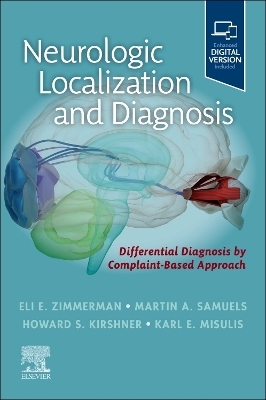
Neurologic Localization and Diagnosis
Elsevier - Health Sciences Division (Verlag)
978-0-323-81280-1 (ISBN)
Offers a comprehensive approach to neurologic diagnosis, essentials of clinical neuroanatomy, localization by dysfunction and anatomy, and diagnosis of suspected disorders.
Concentrates on diagnosis by history and examination wherever possible, but also includes use of specific diagnostic tests where needed.
Addresses clinical evaluation for the purpose of establishing the diagnosis using the most rapid and efficient method possible.
An eBook version is included with purchase. The eBook allows you to access all of the text, figures and references, with the ability to search, customize your content, make notes and highlights, and have content read aloud.
Dr. Eli Zimmerman is an Assistant Professor of Neurology at Vanderbilt University Medical Center. He has multiple clinical and educational roles. Clinically, he sees vascular neurology patients in the inpatient and outpatient settings, as well as via teleneurology. He also serves as the Department of Neurology's Director of Medical Student Education, directs the Vascular Neurology fellowship, and teaches over 200 medical students each year in his leadership of courses in the medical school. He has won multiple teaching awards at Vanderbilt, including the Shovel Award in 2019, awarded by the graduating medical school class to the faculty member who had the most meaningful impact on their medical education. Martin A. Samuels, MD, FAAN, MACP, DSc (hon), is Professor of Neurology at Harvard Medical School and winner of the institution's first Faculty Prize for Excellence in Teaching. He is the Neurologist-in-Chief at Brigham and Women's Hospital, Boston, and former Director of the Harvard-Longwood Neurology Training Program. Dr. Samuels is an internationally renowned teacher-clinician, a premier diagnostician, and a leading authority on the interface between neurology and general medicine. His major fields of expertise include neurocardiology, neurohematology, neurogastroenterology, neurohepatology, neuronephrology, and the neurologic aspects of organ transplantation. He has edited several seminal neurology textbooks, developed a definitive instructional video on clinical neurology for practicing physicians, and authored numerous articles and book chapters. He is the 2006 recipient of the AB Baker Award for Lifetime Achievement in Neurologic Education. Dr. Samuels was the Founding Editor of NEJM Journal Watch Neurology in 1999 and was Editor-in-Chief from 1999 to 2010. Dr. Howard Kirshner is a professor of Neurology, Psychiatry, and Hearing and Speech Sciences. He also holds the positions of vice chairman for the Department of Neurology, director of the Vanderbilt Stroke Center, consultant at the Vanderbilt Stallworth Rehabilitation Hospital, and consulting neurologist at Williamson Medical Center. Dr. Kirshner is board certified in Neurology, Vascular Neurology, and Behavioral Neurology and Neuropsychiatry Dr. Karl Misulis is a neurologist at Vanderbilt University Medical Center, specializing in Hospital Neurology. After a fellowship in neurophysiology, he joined the Vanderbilt faculty practicing general neurology and researching nerve regeneration and brain tumor biology.Dr. Misulis transitioned to West Tennessee Healthcare where he was a hospital neurologist and Chief Medical Information Officer, while retaining his faculty appointment at Vanderbilt. He has returned to full-time practice at Vanderbilt University Hospital as Professor of Clinical Neurology and Director of the Neurology Hospitalist service. He has a secondary appointment as Professor of Clinical Biomedical Informatics. Dr. Misulis is board certified in Neurology by the American Board of Psychiatry and Neurology, certified in Clinical Informatics by the American Board of Preventative Medicine, and certified in EEG by the American Board of Clinical Neurophysiology.He has received numerous awards including being listed in Best Doctors for many years, Doctor of the Year at West Tennessee Healthcare in 2011.Dr. Misulis has published 19 books, with his 20th soon to be released and a 21st in preparation. He has taught medicine around the world, working directly with physicians on three continents, and lecturing on six.
?Part 1. Approach to Neurologic Diagnosis.
Chapter 1.1. Overview of Neurologic Diagnosis
Approaches and why we need more than one.
Algorithmic diagnosis
Syndromic diagnosis
Differential diagnosis
Role of venue in diagnostic approach
Mistakes we make in diagnosis.
Chapter 1.2. Taking a History
Overview and organization
Preparing for the encounter
Chief complaint
History of present illness
Past medical and surgical history
Medication history
Family history
Review of systems
Social history
Chapter 1.3. The Neurologic Exam
Chapter 1.4. The Medical Exam in Neurologic Patients
Chapter 1.5. Synthesis of the Assessment and Plan
Chapter 1.6. Documenting Our Findings.
Part 2. Essentials of Clinical Neuroanatomy.
Chapter 2.1. Overview
Chapter 2.2. Cerebral Hemispheres
Chapter 2.3. Brainstem and Cerebellum
Chapter 2.4. Spinal cord
Chapter 2.5. Peripheral Nerves, Neuromuscular Junction and Muscle
Part 3. Localization by Dysfunction.
Chapter 3.1. Mental Status
Chapter 3.2. Cranial Nerve
Chapter 3.3. Motor.
Chapter 3.4. Sensory
Chapter 3.5. Coordination
Chapter 3.6. Gait
Chapter 3.7. Reflex Abnormalities
Chapter 3.8. Pain
Part 4. Localization by Anatomy.
Chapter 4.1. Cerebrum
Chapter 4.2. Cerebellum
Chapter 4.3. Brainstem and Cranial Nerves
Chapter 4.4. Spinal Cord
Chapter 4.5. Nerve Roots, Plexus, and Peripheral Nerves
Chapter 4.6. Neuromuscular Junction and Muscle
Chapter 4.7. Multi-System Disorders
Part 5. Diagnosis of Suspected Disorders.
Chapter 5.1. Disorders of Mental Status
Chapter 5.2. Speech and Language Disorders
Chapter 5.3. Stroke and other Vascular Disorders
Chapter 5.4. Seizure Disorders
Chapter 5.5. Neuromuscular Disorders
Chapter 5.6. Headache
Chapter 5.7. Movement Disorders
Chapter 5.8. Autoimmune Disorders
Chapter 5.9. Disorders of the Visual System
Chapter 5.10. Vestibular and Related Disorders
Chapter 5.11. Tumors with Neurologic Involvement
| Erscheinungsdatum | 09.11.2022 |
|---|---|
| Verlagsort | Philadelphia |
| Sprache | englisch |
| Maße | 152 x 229 mm |
| Gewicht | 480 g |
| Themenwelt | Medizin / Pharmazie ► Medizinische Fachgebiete ► Neurologie |
| ISBN-10 | 0-323-81280-5 / 0323812805 |
| ISBN-13 | 978-0-323-81280-1 / 9780323812801 |
| Zustand | Neuware |
| Haben Sie eine Frage zum Produkt? |
aus dem Bereich


